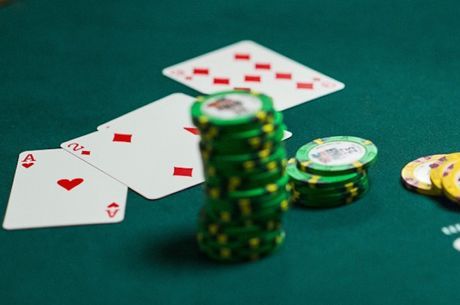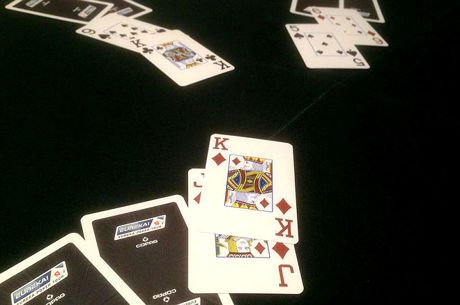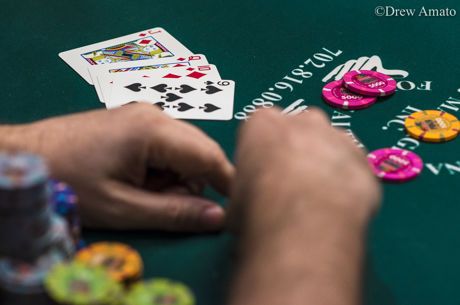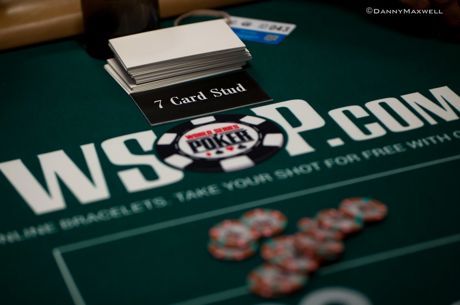Bankroll Builders, Vol. 2: Heads-Up Razz Sit-N-Go's Part 2

When it comes to poker variants, Razz gets a bad rep. Burdened with the stereotypes of being a cranky old man’s game, a fast-track to tilt or an exercise in sheer torture, Razz is actually a fairly simple game to learn. If you can get past the luck factor (which in this game can often times feel compounded when bricks rain on a four-card wheel) and commit to studying the fundamentals, Razz can be an extremely profitable game when played at the lower limits, and an excellent way to grow a bankroll. If you’re bored senseless with no-limit hold’em and are looking to change things up, try a few heads-up Razz sit-n-go's. The variance is lower, the action is swift, and most important, the donkeys are plentiful.
Yesterday we gave you the skinny on how to get started. Hopefully you've gotten yourself acquainted with game and are ready to start mutilating your opponents with these these tips.
Tips from the trenches
- Game selection can mean the difference between a 5% ROI and a 15% ROI. Do your homework and identify the regulars. Skip their tables and prey on the unknown fish. If you must face off with a regular, try and rail one of their matches beforehand to (a) get a sense of their style and range and (b) take a few notes.
In a heads-up Razz SNG, the vast majority of your hands will end by fourth street and begin with one of the following scenarios:
1. The bring-in has a 9,10,J,Q or K showing. The opponent completes with a lower door card (ace through 9) and the bring-in folds.
2. The bring-in has a small card up (A-8). The opponent completes with a lower door card and the bring-in calls. On fourth street, the bring-in catches a small card and the opponent bricks. The bring-in bets and most of the time, the opponent will fold.
3. Conversely, if the bring-in bricks on fourth street and the opponent catches a baby card, a vast majority of the time, the low board will bet and the bring-in will fold. If both players catch good, the hand will play on to the later streets.
Working with that information, come out firing on third street if you have the lower door card. If you have ten-high and your opponent is showing a jack, you have the best hand, so put in that completion and push your edge while you have it. Even if your buried cards are less than ideal, like (8-9)T or even (2-J)T, a completion is almost always correct if your door card is lower than your opponent’s. If the opponent plays back at you with a reraise, that’s another story.
- In heads-up razz, players tend to donate their chips in one of two ways: over-representing hands and bluffing players who cannot fold. A heads-up SNG really boils down to three or four key pots. More often than not, one of those pots will develop when you’ve completed on third with a less-than-ideal hand (a small door card and at least one big card in the hole) and your opponent elects to defend. If you both catch good on fourth but your board is still lowest, you’re likely in the pot for at least another small bet and if fifth street improves your hand again, you’re likely committing a big bet as well in order to represent a made hand. Now, if your opponent bricks on sixth and you catch good again, you might be able to win the pot with one more bet. But this is low-limit, folks. Most players at these levels couldn’t find the fold button if their life depended on it. What if it’s the opposite and you brick on sixth while your opponent improves? Too many players keep firing into the pot on the later streets, praying to either suck out or get their opponent to fold. Most of the time, neither of those things are happening. If your draw is not clearly ahead of your opponent’s by fifth street, prepare to jettison your hand.
- Limit poker is all about saving bets and winning extra bets. You’ll be blown away by the number of low-limit players out there who will keep raising despite showing an obviously inferior hand. Put it this way: if you bet out showing (X-X) 6-8-T and your opponent raises with (X-X) 8-9-Q, it’s ram and jam time.
- Run your trouble hands through a simulator. Make a point of flagging a few questionable hands from your matches and run them through Two Dimes after your session. Chances are you’ll learn something new and valuable.
To try your hand at heads-up Razz SNGs, head over to Full Tilt Poker. And hey, why not follow us on Twitter while you're at it?








